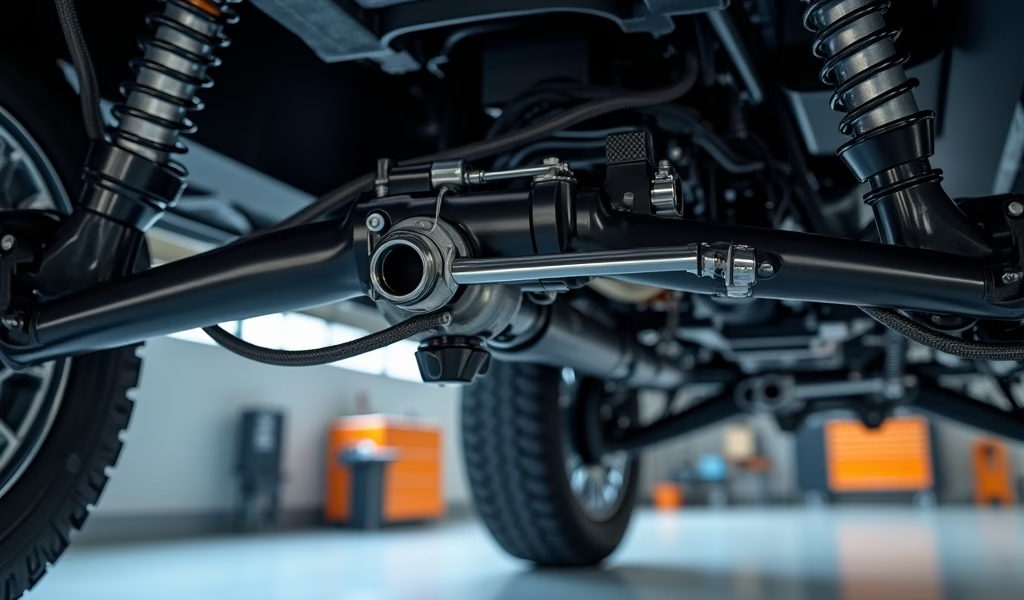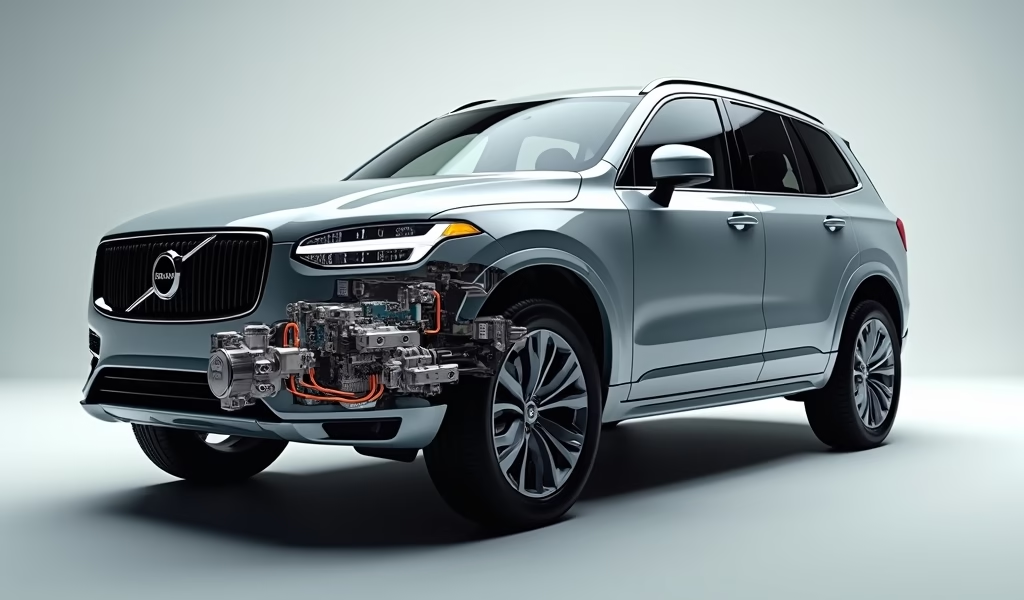Overview
The front axle disconnect actuator is a critical component in 4WD vehicles that engages or disengages power to the front wheels, affecting fuel economy, traction, and overall vehicle performance. Common symptoms of failure include warning lights, grinding noises, and inability to switch between drive modes, while proper maintenance involves regular system use, inspection of connections, and prompt attention to unusual operation.
Table of Contents
- Understanding Front Axle Disconnect Actuator
- How It Works
- Common Symptoms of Failure
- Diagnosing Actuator Problems
- Maintenance Tips
- Replacement Guide
- Performance Considerations
- Cost-Saving Strategies
- Conclusion
- Frequently Asked Questions
Understanding Front Axle Disconnect Actuator
The front axle disconnect actuator is one of those unsung heroes in your 4WD system that doesn’t get much attention until something goes wrong. As a mechanic with 15 years of experience working on 4WD vehicles, I’ve seen how this small component can make or break your off-road adventures.
At its core, the front axle disconnect actuator is the component responsible for engaging or disengaging power to your front wheels. Think of it as the gatekeeper that determines when your vehicle operates in two-wheel drive versus four-wheel drive. When functioning properly, it seamlessly transitions between drive modes, improving your fuel economy on highways and delivering traction when you need it most.
There are three main types of actuators you’ll find in vehicles today:
- Electronic actuators (common in newer vehicles)
- Vacuum-operated actuators (found in many older 4WD systems)
- Cable-operated systems (typically in basic or older 4WD setups)
Each system has its quirks, but they all serve the same purpose: controlling when power flows to your front wheels. The health of your actuator directly impacts your vehicle’s ability to engage 4WD when you need it most – whether you’re navigating a snowy commute or tackling challenging off-road terrain.
How It Works
Let’s break down how this clever little device actually functions. When you press that 4WD button on your dashboard, you’re sending a signal that travels to the actuator. In electronic systems, this triggers a motor that physically moves components in your front axle to connect the drivetrain to your front wheels.
In vacuum-operated systems, that button instead controls vacuum pressure that pulls a diaphragm, which moves the connecting mechanisms. Cable systems work more directly, with a mechanical connection between your selector and the front axle components.

The beauty of the disconnect feature is that it allows your front wheels to spin freely when 4WD isn’t engaged. This reduces drag on the drivetrain, improves fuel economy, and decreases wear on your transfer case components. It’s a clever bit of engineering that gives you the best of both worlds – efficiency when cruising and capability when conditions get rough.
The entire engagement process typically takes just a second or two. Modern electronic systems can make the transition so smoothly you might not even feel it happening. However, that seamless operation depends entirely on a properly functioning actuator.
Common Symptoms of Failure
After working on hundreds of 4WD systems, I’ve noticed some clear patterns when actuators start to fail. These warning signs are your vehicle’s way of asking for help before a minor issue becomes a major headache.
The most obvious sign is when your 4WD system stops engaging altogether. You push the button, but nothing happens – no change in traction, no engagement feeling. Another common symptom is intermittent operation, where 4WD works sometimes but not others.
Here are the telltale symptoms to watch for:
- Dashboard warning lights (4WD, service 4WD, or check engine light)
- Grinding or clicking noises when attempting to engage 4WD
- Delayed engagement or disengagement of the 4WD system
- Vehicle stuck in either 2WD or 4WD mode
- Unusual vibrations when 4WD is engaged
- Increased fuel consumption (if stuck in 4WD mode)
One customer brought in his truck complaining about poor winter performance, only to discover his actuator had failed, leaving him effectively in 2WD despite what his dashboard indicated. Another driver noticed a significant drop in fuel economy because her SUV was permanently stuck in 4WD mode due to a seized actuator.
These symptoms shouldn’t be ignored. Continuing to drive with a malfunctioning actuator can lead to additional damage to your final drive components and drivetrain, turning a relatively simple fix into a costly repair.
Diagnosing Actuator Problems
Before you rush to replace parts, let’s figure out what’s actually wrong. Proper diagnosis saves both time and money. Even if you’re planning to have a professional handle the repair, understanding the diagnostic process helps you communicate more effectively with your mechanic.
Start with the basics: scan for trouble codes. Most modern vehicles will store specific codes when actuator problems occur. Common codes include P1816, P1818, and P1819, though the exact codes vary by manufacturer. An affordable OBD-II scanner can retrieve these codes, giving you valuable information.
Next, perform a simple functional test. With the engine running and the transmission in neutral, attempt to engage and disengage 4WD while listening for the actuator motor. You should hear a brief whirring sound as it operates. No sound could indicate an electrical issue or motor failure.
For vacuum-operated systems, check the vacuum lines for cracks, disconnections, or leaks. A vacuum gauge can help determine if proper vacuum pressure is reaching the actuator. According to Motor Magazine’s technical studies, even small vacuum leaks can prevent proper actuator function.
For electronic actuators, use a multimeter to verify proper voltage at the connector when 4WD is engaged. No voltage suggests a wiring, fuse, or control module issue. Proper voltage but no operation points to a failed actuator motor.
Remember to inspect the physical condition of the actuator and surrounding components. Look for signs of damage, corrosion, or leaking fluid. Sometimes the problem is as simple as a corroded electrical connector or a broken vacuum line.
Maintenance Tips
An ounce of prevention is worth a pound of cure, especially when it comes to 4WD components. The good news is that maintaining your front axle disconnect actuator isn’t complicated or time-consuming.
First and foremost, use your 4WD system regularly, even if you don’t need it. I recommend engaging 4WD at least once a month for a short drive (5-10 minutes). This keeps components moving and prevents seals from drying out. It’s similar to how you shouldn’t leave a car sitting unused for months – moving parts need to move occasionally!
For vehicles with electronic actuators, inspect the wiring connections annually. Look for corrosion, loose connections, or damaged wires. A little dielectric grease on the connectors goes a long way in preventing moisture-related problems, especially if you live in a humid or coastal area.
If your vehicle has a vacuum-operated system, check the vacuum lines every 15,000 miles or during regular service intervals. These rubber hoses can crack with age and heat exposure. The Car and Driver maintenance guide suggests that proper vacuum system maintenance can extend component life by up to 40%.
Keep your 4WD components clean, especially after off-road adventures. Mud, salt, and debris can accelerate corrosion and interfere with proper operation. A thorough undercarriage wash after off-roading or winter driving helps protect these vital components.
Finally, address any unusual noises or operation immediately. Catching problems early often means simpler, less expensive repairs. Don’t ignore that clicking sound when engaging 4WD – it’s your vehicle trying to tell you something!

Replacement Guide
When the time comes to replace your actuator, you have some decisions to make. Should you go with an OEM part or aftermarket? Should you tackle the job yourself or leave it to the professionals?
For most vehicles, actuator replacement is a moderate-difficulty job. If you’re comfortable working on your vehicle and have basic tools, you can likely handle it. However, access can be challenging on some models, requiring removal of skid plates, shields, or other components.
Start by gathering the right tools and parts. You’ll need basic hand tools, a torque wrench, and possibly specialized tools depending on your vehicle. Always consult a service manual for torque specifications and proper procedures.
When selecting a replacement part, OEM components offer the most reliable fit and function but at a premium price. Quality aftermarket parts from reputable manufacturers can provide good performance at a lower cost. I’ve had good experiences with Dorman, Standard Motor Products, and 4WD Hardware components.
The replacement process typically involves:
- Disconnecting the battery
- Locating and accessing the actuator (often near the front differential)
- Removing electrical connections or vacuum lines
- Removing mounting hardware
- Installing the new actuator in reverse order
- Testing operation before finalizing installation
Pay special attention to electrical connections. Ensure they’re clean, secure, and properly seated. For vehicles with universal joints in the driveshaft, verify proper alignment during reassembly to prevent vibration issues.
After installation, clear any trouble codes and perform a functional test. Drive the vehicle in both 2WD and 4WD modes to ensure proper operation. Listen for unusual noises and feel for any vibrations or binding.
Performance Considerations
For those who regularly use their 4WD system in demanding conditions, there are performance upgrades worth considering. These modifications can enhance reliability and capability, though they come with tradeoffs.
Heavy-duty actuators designed for off-road use often feature strengthened components and better sealing against the elements. These can withstand the rigors of frequent engagement and harsh conditions better than standard units. Brands like ARB and Warn offer respected upgrades for many popular 4WD vehicles.
Some enthusiasts opt for manual override systems that allow for mechanical engagement if the electric or vacuum system fails. This redundancy can be valuable during remote adventures where getting stranded isn’t an option.
Keep in mind that performance modifications may affect other vehicle systems. More robust actuators might engage more firmly, creating additional drivetrain stress. Some modifications may also impact warranty coverage on newer vehicles.
If you’re considering performance upgrades, I recommend consulting with specialists who understand both the benefits and limitations. The off-road experts at Four Wheeler Network provide excellent guidance on which modifications deliver the best value for different driving styles.
For most daily drivers who occasionally venture off-road, standard OEM-quality replacements provide the best balance of reliability, cost, and performance. Save the specialized upgrades for dedicated trail rigs or vehicles regularly subjected to extreme conditions.
Cost-Saving Strategies
Replacing an actuator doesn’t have to break the bank. With some smart strategies, you can minimize costs while still getting reliable performance.
First, explore rebuilt or remanufactured options. Quality rebuilt actuators typically cost 30-40% less than new OEM parts while offering similar reliability. Ensure they come with a solid warranty – at least 12 months is reasonable.
Consider doing the diagnostic work yourself, even if you plan to have a shop handle the actual replacement. Walking in with a specific diagnosis can save diagnostic fees and prevent unnecessary parts replacement. Those blinking dashboard lights might indicate an actuator problem, but they could also signal something as simple as a loose connection.
For the DIY crowd, replacement costs typically break down as:
- OEM actuator: $200-450 depending on vehicle
- Quality aftermarket: $120-300
- Rebuilt/remanufactured: $100-250
- Basic tools (if you don’t already have them): $50-100
Professional installation typically adds $150-300 in labor, depending on your vehicle and local labor rates. Some models require significant disassembly to access the actuator, driving up labor costs.
For those comfortable with online shopping, sites specializing in OEM parts often offer significant discounts compared to dealership prices. Just ensure you’re getting the correct part number for your specific vehicle model and year.
Finally, preventative maintenance remains the most cost-effective strategy. Regular system checks and addressing minor issues promptly can prevent catastrophic failures that require more extensive repairs.
Conclusion
The front axle disconnect actuator may be a small component in your 4WD system, but its impact on performance, reliability, and driving experience is significant. Understanding how it works and recognizing the warning signs of failure helps you maintain your vehicle’s capability when you need it most.
Whether you’re a weekend warrior who occasionally hits the trails or someone who relies on 4WD for daily driving in challenging conditions, proactive maintenance of your actuator system pays dividends. Regular system checks, addressing unusual noises or operation immediately, and using your 4WD system periodically all contribute to longer component life.
When replacement becomes necessary, weigh your options carefully. Consider your driving habits, budget, and how long you plan to keep the vehicle. Quality parts and proper installation ensure reliable performance for years to come.
Remember that your 4WD system is only as strong as its weakest link. A well-maintained front axle disconnect actuator ensures that when you need traction most, your vehicle will respond accordingly – keeping you moving forward safely and confidently.
Frequently Asked Questions
What exactly does a front axle disconnect actuator do?
It engages or disengages power to your front wheels when switching between 2WD and 4WD modes. This component allows your vehicle to operate more efficiently in 2WD on normal roads while providing the ability to engage 4WD when needed for traction.
How much does it cost to replace a front axle disconnect actuator?
Replacement costs typically range from $250-650 including parts and labor, depending on your vehicle make and model. DIY replacement can save $150-300 in labor costs if you have the necessary tools and mechanical skills.
Can I drive with a bad front axle disconnect actuator?
Yes, but with limitations depending on how it failed. If stuck in 2WD, you’ll lose off-road capability but can drive normally on paved roads; if stuck in 4WD, you should avoid high speeds and expect reduced fuel economy.
How do I know if my front axle disconnect actuator is bad?
Warning signs include 4WD warning lights on the dashboard, grinding noises when engaging 4WD, inability to switch between 2WD and 4WD, and unusual vibrations. You might also notice increased fuel consumption if the system is stuck in 4WD mode.
How often should a front axle disconnect actuator be replaced?
There’s no standard replacement interval as it’s not typically a maintenance item. Most actuators last 80,000-120,000 miles under normal conditions, though frequent off-road use or harsh environments may shorten lifespan.

